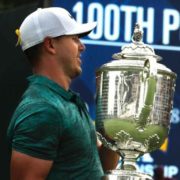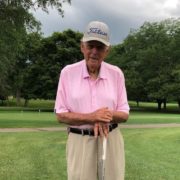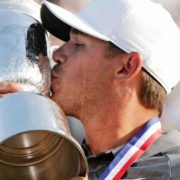Brooks Koepka wasn’t losing to anyone, not even Tiger Woods
ST LOUIS — He could hear the roars. How could he not? It felt, at times, like the Bellerive Country Club was vibrating. Brooks Koepka, however, wouldn’t look in the direction of them. He just kept marching forward, often with his head down and a tiny smirk on his face.
Up ahead, it was obvious Tiger Woods was pouring in birdies. The fairy-tale finish at the PGA Championship that everyone seemed to be longing for was taking shape. It was starting to feel like a remake of the 1986 Masters, with Koepka playing the role of Greg Norman, and Tiger morphing into Jack Nicklaus. The sentimental favorite was going to conjure up some old magic, and the young and brash phenom was going to wilt. The pressure was mounting with each roar.
“Everybody on the golf course could hear it,” Koepka said. “You could hear it trickle down as they changed the scoreboards. You’d hear different roars every three seconds. It was pretty obvious when Tiger made a birdie.”
But this wasn’t 1986. There was one significant difference this time. In this version, the brawny, confident antihero never blinked. You don’t have to love it, but Koepka was so icy and impressive amid the circus, you have to respect it. After holding off Woods for a two-stroke victory, Koepka now has three major championships at the age of 28. He did what Woods used to do in his prime, grabbing the lead and then stepping on the accelerator every time someone got close.
“Other than me and my team, I think everybody was rooting for Tiger,” Koepka said. “As they should. He’s the greatest player to ever to play the game. [Woods] is the whole reason people of my generation are even playing golf. To duel it out with him, I don’t think I ever dreamed of that situation today.”
Historically, it’s always been easy to compare Woods and Nicklaus. They dominated their eras like no one before them or since. And interestingly, there are a lot of similarities between Koepka and Norman. They’re both fitness freaks, both historically great drivers and both walked with a swagger and a chip on their shoulder. There appears to be one major difference, however: Norman tended to melt in big moments, and Koepka seems to live for them.
Need an example? When Woods birdied the 15th hole on Sunday to pull within a shot at 13-under par — nearly dunking his approach from the fairway — it was bedlam. Even if you shouted, you could barely hear your own voice above the din. Woods punched the air in jubilation, seemingly feeding off the gallery’s energy. “I wish we could play in front of crowds like this every single week because this is a true pleasure,” Woods said.
Koepka couldn’t help but smile, listening to it unfold.
“It brought me back to when I was a kid, when I was watching him, and you heard those roars,” Koepka said.
But instead of getting starstruck, Koepka uncorked a 334-yard drive on 15, hit his approach to 10 feet and made the birdie.
“He’s a tough guy to beat when he’s hitting it 340 in the air,” Woods said, talking about Koepka’s game with the same kind of awe Woods’ elders used to talk about his. “[Hitting it] 320 in the air is like a chip shot [for him]. That’s the new game.”
Koepka wasn’t done. He stood on the daunting 16th tee, a 248-yard par 3, and hit arguably the best shot of his entire week, ripping a 4-iron that landed soft and trickled to within 6 feet of the pin.
“That was like a laser,” said Koepka’s caddie, Ricky Elliott. “He had to push the button. He had to give himself a cushion coming down the last few holes. The wedge on 15 was huge too, but that 4 iron, it never left the stick.”
“That’s probably going to go down as one of the best shots I’ve ever hit under pressure,” Koepka said.
When he drained the birdie putt, Koepka’s lead was back to two strokes. A birdie by Woods on 18, and bogey by Adam Scott on the same hole, gave Woods sole claim to second place. But even a final-round 64, Woods’ best Sunday round ever in a major, wasn’t enough.
“Surreal, that’s all I can say,” Koepka said.
It’s hard to surmise, at the moment, just how good, in historical terms, Koepka might be. Only four other players have ever won the U.S. Open and the PGA Championship in the same year. It’s some pretty robust company: Gene Sarazen (1922), Ben Hogan (1948), Nicklaus (1980) and Woods (2000).
You can argue that Koepka, if he keeps this up, could go down as one of the best American golfers ever, a thought he said hadn’t even occurred to him until he was asked about it Sunday night.
“I actually never thought about that,” Koepka said, grinning as he turned that potential reality over in his mind. “Three majors at 28 — it’s a cool feeling. It really is. You know, hopefully I can stay healthy. I’ve kind of had some trouble with that over the past two years, three years. I think I’m much more disciplined now, so I should be able to play every major, making sure my body’s healthy. But I’m excited. I’m excited for the next few years. I mean, as fans — and I’m a fan of golf — you should be excited. I mean, Tiger’s come back. You look at what Dustin [Johnson is] doing, Justin [Thomas], Rory [McIlroy], [Jordan] Spieth. It’s a great time to be a golf fan. I can’t wait to duel it out with them over the next couple years.”
There was a time when Woods — having finished second — would have been on his private jet by the time the last putt dropped. But this time was different. He hung around until Koepka was finished and offered him a hearty bear hug after the winner had signed his scorecard.
“I could hear it!” Koepka said, referencing the roars.
In truth, we all could. It was still special. But the game rolls on, and new faces emerge. The past is fun to revisit, but as Koepka can attest, the present is pretty damn good too.










